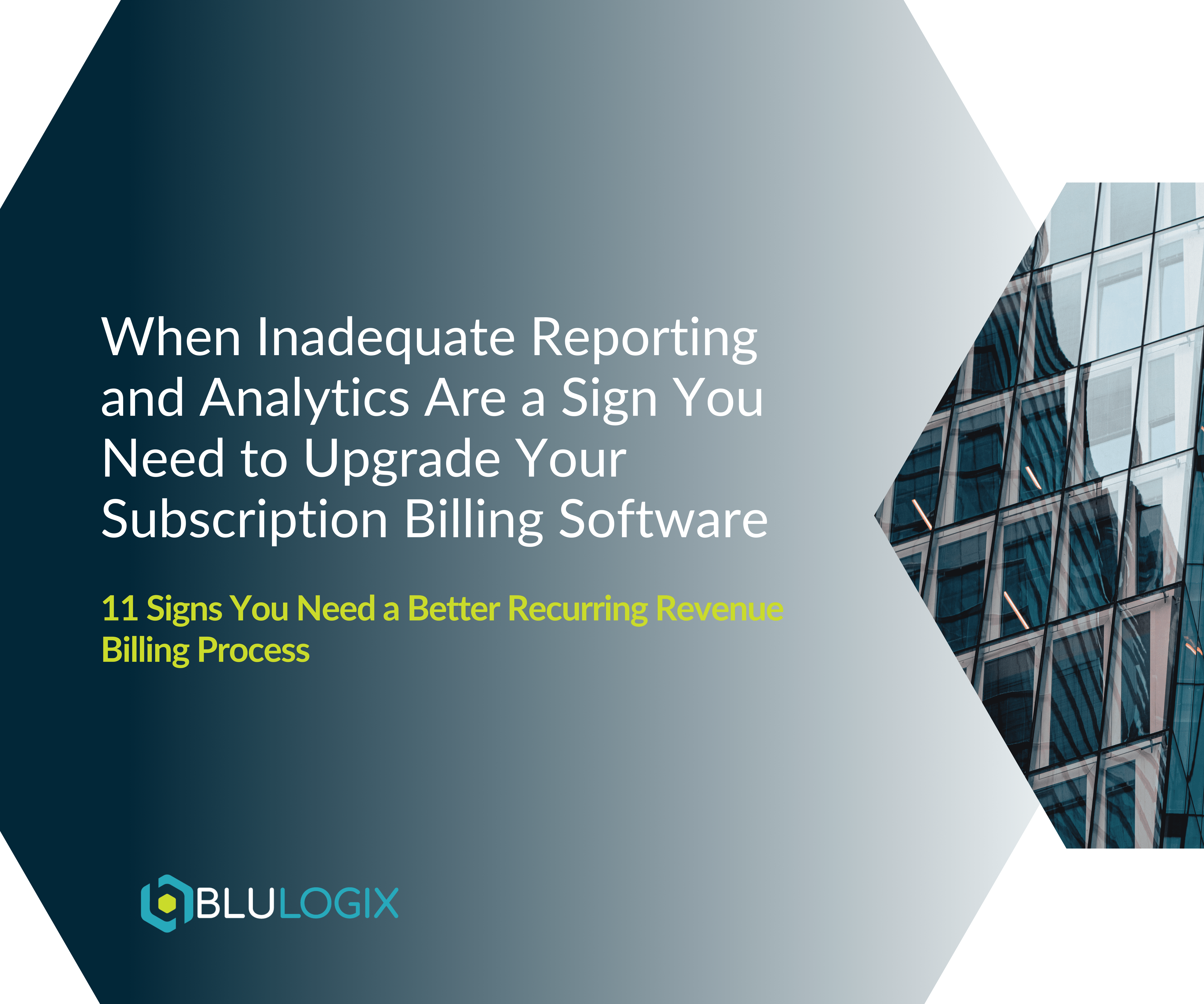What are the Most Important Considerations When Evaluating Subscription Billing Solutions?
Welcome to the fourth installment of our comprehensive guide on selecting the right subscription billing platform. Before we go much further, let’s go deep into essential definitions and concepts in the world of subscription billing. Whether you’re new to the subscription billing landscape or looking to deepen your understanding, this guide will demystify the jargon and provide you with the knowledge you need to make informed decisions for your business.
Introduction
Subscription billing is at the core of many successful modern businesses. It’s a dynamic field that encompasses a wide range of terms and concepts. Understanding these terms is crucial, as they form the building blocks of any subscription-based business model. Let’s explore the key definitions that every business owner, finance professional, and product manager should know.
Take your business further with BluIQ’s flexible, scalable, enterprise-grade intelligent billing solutions.
1. Subscription Billing
Definition: Subscription billing is a business model in which customers pay a recurring fee at regular intervals, typically monthly or annually, in exchange for access to a product or service.
Importance: Understanding the core concept of subscription billing is crucial because it forms the foundation of any subscription-based business model. It’s the engine that drives revenue predictability and customer relationships.
Example: Netflix charges customers a monthly fee for access to its streaming content.
2. Recurring Revenue
Definition: Recurring revenue refers to the portion of a company’s total revenue that comes from subscription-based products or services. It represents predictable income that continues over time.
Importance: Recurring revenue is a key financial metric for subscription businesses. It provides stability and long-term sustainability by reducing reliance on one-time sales.
Example: Adobe generates recurring revenue through its subscription-based Adobe Creative Cloud service.
3. Churn Rate
Definition: Churn rate, also known as attrition rate, measures the percentage of customers who cancel their subscriptions within a specific period.
Importance: A high churn rate can erode your recurring revenue quickly. Monitoring and reducing churn is essential for long-term profitability.
Example: A software-as-a-service (SaaS) company tracks how many customers cancel their monthly subscriptions.
4. Subscription Management
Definition: Subscription management involves handling all aspects of a subscription, from sign-up and billing to customer support and cancellation.
Importance: Efficient subscription management is crucial for providing a seamless customer experience and minimizing churn.
Example: An online magazine uses subscription management software to handle new sign-ups, billing, and customer inquiries.
5. Usage-Based Billing
Definition: Usage-based billing charges customers based on their actual usage of a product or service. This can include variable charges for data, minutes, or other measurable metrics.
Importance: Usage-based billing allows businesses to align pricing with value and encourages customer adoption of additional features.
Example: A cloud storage provider charges customers based on the amount of data they store each month.
6. Metering
Definition: Metering involves tracking and measuring a customer’s usage of specific resources, such as data, storage, or server processing.
Importance: Accurate metering is essential for calculating usage-based charges and ensuring fair billing.
Example: An internet service provider measures and records the data usage of each customer’s internet plan.
7. Revenue Recognition
Definition: Revenue recognition is the accounting process that determines when and how revenue is recognized on the financial statements.
Importance: Proper revenue recognition ensures compliance with accounting standards and reflects the true financial health of a subscription-based business.
Example: A software company follows specific revenue recognition rules to report income from its subscription sales accurately.
8. Dunning
Definition: Dunning is the process of notifying customers about failed payments and attempting to collect overdue amounts.
Importance: Effective dunning processes are crucial for reducing involuntary churn due to payment failures.
Example: A subscription box service sends automated dunning emails to customers with expired credit cards.
9. Customer Lifecycle
Definition: The customer lifecycle represents the stages a customer goes through, from initial awareness and consideration to purchase, retention, and advocacy.
Importance: Understanding the customer lifecycle helps tailor marketing, sales, and retention efforts to specific stages.
Example: An e-commerce business creates targeted marketing campaigns for customers at different lifecycle stages.
10. Customer Acquisition Cost (CAC)
Definition: CAC is the cost a business incurs to acquire a new customer. It includes marketing, sales, and onboarding expenses.
Importance: Monitoring CAC helps ensure that customer acquisition efforts are cost-effective and sustainable.
Example: A software company calculates the costs of its marketing campaigns and sales team to determine CAC.
11. Customer Lifetime Value (CLV or LTV)
Definition: CLV is the predicted net profit a business can expect to earn from a customer throughout their relationship.
Importance: Maximizing CLV is essential for long-term profitability and justifies investments in customer acquisition and retention.
Example: A subscription-based streaming service estimates the CLV of its average customer over a five-year period.
12. Proration
Definition: Proration is the calculation of charges or credits for a subscription that starts or ends mid-billing cycle.
Importance: Proration ensures fair billing when customers make changes to their subscriptions.
Example: A software company prorates its subscription fees when a customer upgrades their plan mid-month.
13. Tiered Pricing
Definition: Tiered pricing offers different subscription levels, each with varying features and price points. Customers can choose the tier that best suits their needs.
Importance: Tiered pricing allows businesses to cater to a broader range of customers and maximize revenue.
Example: A cloud storage provider offers tiered pricing with options for different storage capacities and features.
14. Integration
Definition: Integration involves connecting different software systems to work together seamlessly, often using application programming interfaces (APIs).
Importance: Integration enables data flow between systems, streamlines operations, and enhances the overall customer experience
15. Data Staging & Mediation
Definition: Data staging and mediation involve collecting, processing, and transforming data from various sources before it’s used for billing and reporting purposes.
Importance: Data staging and mediation ensure that billing data is accurate and consistent, even when it originates from diverse sources.
Example: A telecommunications company gathers call detail records from different networks and standardizes them through data staging and mediation processes.
16. Integration & Provisioning
Definition: Integration and provisioning involve connecting a subscription billing platform with other systems (e.g., CRM, ERP) to automate processes like customer onboarding, provisioning, and activation.
Importance: Integration and provisioning streamline operations, reduce manual tasks, and enhance the customer experience.
Example: A software company integrates its subscription billing platform with its CRM system to automate customer onboarding and provisioning.
17. Activation
Definition: Activation refers to the process of granting customers access to a product or service immediately after they’ve subscribed or purchased it.
Importance: Efficient activation processes ensure that customers can start using their subscriptions without delays, leading to a positive customer experience.
Example: A streaming service provides customers with instant access to its content library upon subscription.
18. Digital Inventory
Definition: Digital inventory management involves tracking and managing digital assets, such as licenses, content, or virtual products.
Importance: Digital inventory management is crucial for businesses that provide digital products or services.
Example: An e-learning platform manages its digital course catalog using digital inventory tools.
19. Margin Analyzer
Definition: Margin analyzer tools provide insights into the profitability of different products, services, or customer segments.
Importance: Margin analysis helps businesses make informed pricing and product decisions to maximize profitability.
Example: A SaaS company uses a margin analyzer to determine which pricing plans generate the highest margins.
20. Channel Management
Definition: Channel management involves overseeing the distribution channels through which products or services are sold, including direct sales, partners, and resellers.
Importance: Effective channel management ensures that products reach customers efficiently and that partners are adequately supported.
Example: A software company maintains relationships with resellers to expand its market reach.
In this extensive exploration of key definitions in the realm of subscription billing, we’ve covered essential concepts that play a pivotal role in the success of subscription-based businesses. Armed with this knowledge, you’ll be better equipped to navigate the intricacies of subscription billing and make strategic decisions for your organization.
Understanding these terms is just the beginning of your journey to mastering subscription billing. In our next post, we’ll continue our exploration by providing valuable insights into evaluating subscription billing solutions. Stay tuned for more expert guidance on your path to subscription billing excellence.
Take your business further with BluIQ’s flexible, scalable, enterprise-grade intelligent billing solutions.
Learn more

How to Pivot When Cumbersome Customer Management Derails Your Subscription Model
Effective customer management is vital for retaining clients and maintaining high satisfaction levels in any subscription-based business model. However, many companies face challenges with

When Inadequate Reporting and Analytics Are a Sign You Need to Upgrade Your Subscription Billing Software
In the complex landscape of B2B subscription billing, the ability to generate comprehensive and insightful reports is crucial. Businesses often struggle with outdated or

How to Make Sure Inefficient Revenue Recognition Don’t Tank Your Subscription Offerings
Efficient revenue recognition is crucial for accurate financial reporting and compliance with accounting standards such as ASC 606 and IFRS 15. These standards require

